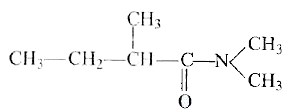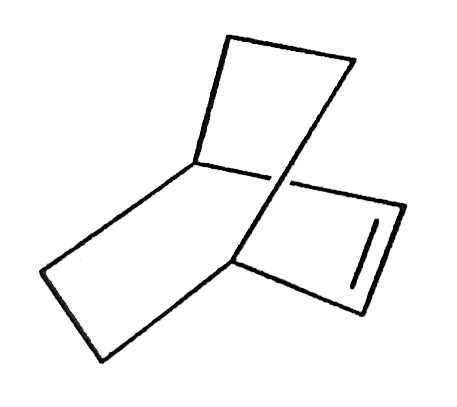EtCOOMe(A)(i)NH2NH2(ii)HNO2−−−−−−−−−−−−→(iii)ӨOH(iv)H3O⊕(B)
The product (B) is :
MeNH2
EtNH2
MeCONH2
EtCONHMe
The correct Answer is:B
To solve the given problem, we will go through the reactions step by step.
Step 1: Identify the starting compound (A)
The starting compound is Ethyl Methyl Carboxylate (EtCOOMe), which can be represented as:
- Ethyl group (Et) = C2H5
- Methyl group (Me) = CH3
Thus, the structure can be written as:
EtCOOMe≡C2H5COOCH3
Step 2: Reaction with Hydrazine (NH2NH2)
When Ethyl Methyl Carboxylate reacts with hydrazine (NH2NH2), it undergoes a nucleophilic substitution where the hydrazine replaces the methoxy group (OMe):
EtCOOMe+NH2NH2→EtCOONHNH2
This gives us Ethyl Hydrazone:
EtCOONHNH2
Step 3: Reaction with Nitrous Acid (HNO2)
The next step involves the reaction with nitrous acid (HNO2), which converts the hydrazine group (NH2) to a hydroxyl group (OH):
EtCOONHNH2+HNO2→EtCOONH2OH
This results in the formation of an intermediate compound with a hydroxyl group:
EtCOONH2OH
Step 4: Reaction with Hydroxide Ion (OH-)
The intermediate compound then reacts with hydroxide ion (OH-), leading to the loss of a water molecule:
EtCOONH2OH+OH−→EtCOONH
This results in the formation of a compound with an amine group:
EtCOONH
Step 5: Rearrangement (Lossen Rearrangement)
The next step involves a rearrangement known as Lossen rearrangement, where the ethyl group migrates to the nitrogen:
EtCOONH→EtNCO
This gives us an isocyanate:
EtNCO
Step 6: Reaction with Hydronium Ion (H3O+)
Finally, when the isocyanate reacts with hydronium ion (H3O+), it hydrolyzes to form an amine:
EtNCO+H3O+→EtNH2+CO2
This results in the formation of Ethylamine (EtNH2) and carbon dioxide (CO2).
Final Product (B)
The final product (B) is:
EtNH2
Summary of Steps:
1. Identify starting compound (A): Ethyl Methyl Carboxylate (EtCOOMe).
2. React with hydrazine (NH2NH2): Forms Ethyl Hydrazone (EtCOONHNH2).
3. React with nitrous acid (HNO2): Converts NH2 to OH, forming (EtCOONH2OH).
4. React with hydroxide ion (OH-): Leads to loss of water, forming (EtCOONH).
5. Undergo Lossen rearrangement: Ethyl group migrates to nitrogen, forming (EtNCO).
6. React with hydronium ion (H3O+): Hydrolyzes to form Ethylamine (EtNH2) and CO2.
The starting compound is Ethyl Methyl Carboxylate (EtCOOMe), which can be represented as:
- Ethyl group (Et) = C2H5
- Methyl group (Me) = CH3
Thus, the structure can be written as:
EtCOOMe≡C2H5COOCH3
When Ethyl Methyl Carboxylate reacts with hydrazine (NH2NH2), it undergoes a nucleophilic substitution where the hydrazine replaces the methoxy group (OMe):
EtCOOMe+NH2NH2→EtCOONHNH2
This gives us Ethyl Hydrazone:
EtCOONHNH2
The next step involves the reaction with nitrous acid (HNO2), which converts the hydrazine group (NH2) to a hydroxyl group (OH):
EtCOONHNH2+HNO2→EtCOONH2OH
This results in the formation of an intermediate compound with a hydroxyl group:
EtCOONH2OH
The intermediate compound then reacts with hydroxide ion (OH-), leading to the loss of a water molecule:
EtCOONH2OH+OH−→EtCOONH
This results in the formation of a compound with an amine group:
EtCOONH
The next step involves a rearrangement known as Lossen rearrangement, where the ethyl group migrates to the nitrogen:
EtCOONH→EtNCO
This gives us an isocyanate:
EtNCO
Finally, when the isocyanate reacts with hydronium ion (H3O+), it hydrolyzes to form an amine:
EtNCO+H3O+→EtNH2+CO2
This results in the formation of Ethylamine (EtNH2) and carbon dioxide (CO2).
The final product (B) is:
EtNH2
1. Identify starting compound (A): Ethyl Methyl Carboxylate (EtCOOMe).
2. React with hydrazine (NH2NH2): Forms Ethyl Hydrazone (EtCOONHNH2).
3. React with nitrous acid (HNO2): Converts NH2 to OH, forming (EtCOONH2OH).
4. React with hydroxide ion (OH-): Leads to loss of water, forming (EtCOONH).
5. Undergo Lossen rearrangement: Ethyl group migrates to nitrogen, forming (EtNCO).
6. React with hydronium ion (H3O+): Hydrolyzes to form Ethylamine (EtNH2) and CO2.
Topper's Solved these Questions
- CARBOXYLIC ACIDS AND THEIR DERIVATIVESBOOK - CENGAGE CHEMISTRY ENGLISHCHAPTER - CARBOXYLIC ACIDS AND THEIR DERIVATIVESEXERCISE - Exercises (Assertion-Reasoning)
10 Videos
- CARBOXYLIC ACIDS AND THEIR DERIVATIVESBOOK - CENGAGE CHEMISTRY ENGLISHCHAPTER - CARBOXYLIC ACIDS AND THEIR DERIVATIVESEXERCISE - Exercises Archives (Single Correct)
10 Videos
- CARBOXYLIC ACIDS AND THEIR DERIVATIVESBOOK - CENGAGE CHEMISTRY ENGLISHCHAPTER - CARBOXYLIC ACIDS AND THEIR DERIVATIVESEXERCISE - Exercises (Multiple Correct)
34 Videos
- BIOMOLECULESBOOK - CENGAGE CHEMISTRY ENGLISHCHAPTER - BIOMOLECULESEXERCISE - Exercises Archives (Analytical And Descriptive)
8 Videos
- CHEMICAL KINETICSBOOK - CENGAGE CHEMISTRY ENGLISHCHAPTER - CHEMICAL KINETICSEXERCISE - Archives Subjective
23 Videos
Similar Questions
Knowledge Check
H3C−CH2−CH3∣CH−C∣∣O−NH2Br2+KOH−−−−−−−−−→ΔA1.CH3I(excess)−−−−−−−−−−−−→2.AgOH,ΔB
The major product (B) is :ACH3−CH2−CH=CH2B CH3C−CH=CH−CH3D
CH3C−CH=CH−CH3D
CH3−O∣∣C−O−HNaH14CO3−−−−−→(A)(gas)(i)PhMgBr−−−−−−−→(ii)H3O⊕(B)
CH3−O∣∣S∣∣O−O−HNaH14CO3−−−−−→(C)gas(i)PhMgBr−−−−−−−→(ii)H3O⊕(D)
Product (B) and (D) in the above reaction are :APh−O∣∣C−O−H,Ph−O∣∣S∣∣O−O−HBPh−O∣∣C14−O−H,Ph−O∣∣S−O−HCPh−O∣∣C14−O−H,Ph−O∣∣C14−O−HDPh−O∣∣C−OH,Ph−O∣∣S−O−H
PhCOOH(A)(i)N2H,H⊕−−−−−−−−→(ii)Δ(B)H2O/ӨOH−−−−−→(C)
Which of the following statement is /are correct about the reaction ?
View Solution Me−≡−HNaNH2−−−−−−→+liq.NH3 (C ) H3O⊕−−−→ (D)
Me−≡−HNaNH2−−−−−−→+liq.NH3 (C ) H3O⊕−−−→ (D)
the final product (D) is:
View Solution (i)O3−−−−−−−−→(ii)Zn−H2O¯:OH−−→Δ NO. of aldol condensation product.
(i)O3−−−−−−−−→(ii)Zn−H2O¯:OH−−→Δ NO. of aldol condensation product.
View SolutionIn the reaction,
C6H5NH2NaNO2+HCl−−−−−−−−→0−5∘C(A)CuCN−−−→KCN(B)H+/H2O−−−−−→(C)
the product (C) is
View SolutionComplete the following reactions:
Benzene(A) Ac2O−−−−→+AICI3 (B) (i)MeMgBr−−−−−−−→(ii)H3O(+) (C) Conc.H2SO4 (D) 1.BH3/THF−−−−−−−−−−→2.H2O2/O(−)H (E)
View SolutionCH2OH∣ C=O∣ (CHOH)3∣ CH2OHNaBH4−−−−→A+B
Fructose
The product A and B in the a above reaction are not
View Solution
